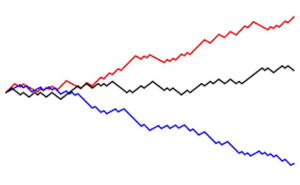This is a rather important topics for anyone interested in doing Finance.
Lets look at their definition first.
A Martingale is a random process ![]() with respect to the information filtration
with respect to the information filtration ![]() and the probability distribution
and the probability distribution ![]() , if
, if
![]() for all
for all ![]()
![]() for all
for all ![]()
Martingales are used widely and one example is to model fair games, thus it has a rich history in modelling of gambling problems. If you google Martingale, you will get an image related to a Horse, because it started with Horse-betting.
We define a submartigale by replacing the above condition 2 with
![]() for all
for all ![]()
and a supermartingale with
![]() for all
for all ![]() .
.
Take note that a martingale is both a submartingale and a supermartingale. Submartingale in layman terms, refers to the player expecting more as time progresses, and vice versa for supermartingale.
Let us try to construct a Martingale from a Random Walk now.
Let ![]() be a random walk where the
be a random walk where the ![]() ’s are IID with mean
’s are IID with mean ![]() .
.
Let ![]() . Then
. Then ![]() is a martingale because:
is a martingale because:
![]()
![]()
![]() since expectation distributes linearly
since expectation distributes linearly
![]()
![]()
So how will a martingale betting strategy be like?
Here, we let ![]() be IID random variables with
be IID random variables with ![]() . We can imagine
. We can imagine ![]() to represent the result of a coin-flipping game where,
to represent the result of a coin-flipping game where,
– player win ![]() latex X_i = 1
latex X_i = 1![]() 1 if the coin comes up tails, that is,
1 if the coin comes up tails, that is, ![]()
Consider further now a doubling strategy where we keep doubling the bet until we eventually win. Once we win, we stop and our initial bet is ![]() latex n^{th}
latex n^{th}![]() latex 2^{n-1}
latex 2^{n-1}![]() latex W_n
latex W_n![]() latex W_0 = 0
latex W_0 = 0![]() latex W_n
latex W_n![]() latex W_n \in \{ 1, -2^n +1 \}
latex W_n \in \{ 1, -2^n +1 \}![]() latex n^{th}
latex n^{th}![]() latex W_n = -(1 + 2 + \ldots + 2^{n-2}) + 2^{n-1}latex = -(2^{n-1} – 1) + 2^{n-1} = 1
latex W_n = -(1 + 2 + \ldots + 2^{n-2}) + 2^{n-1}latex = -(2^{n-1} – 1) + 2^{n-1} = 1![]() latex W_n = -(1 + 2 + \ldots + 2^{n-1}) = -2^n +1
latex W_n = -(1 + 2 + \ldots + 2^{n-1}) = -2^n +1![]() latex W_n
latex W_n![]() latex \mathbb{E}[W_{n+1} | W_n] = W_n
latex \mathbb{E}[W_{n+1} | W_n] = W_n![]() latex W_n = 1
latex W_n = 1![]() latex P(W_{n+1} = 1 | W_n = 1) = 1
latex P(W_{n+1} = 1 | W_n = 1) = 1![]() latex \mathbb{E}[W_{n+1} | W_n = 1] = 1 = W_n
latex \mathbb{E}[W_{n+1} | W_n = 1] = 1 = W_n![]() latex W_n = -2^n +1
latex W_n = -2^n +1![]() latex 2^n
latex 2^n![]() latex (n+1)^{th}
latex (n+1)^{th}![]() latex W_{n+1} \in \{ 1 , -2^{n+1} + 1 \}
latex W_{n+1} \in \{ 1 , -2^{n+1} + 1 \}![]() latex P(W_{n+1} = 1) | W_n = -2^n +1) = \frac{1}{2}
latex P(W_{n+1} = 1) | W_n = -2^n +1) = \frac{1}{2}![]() latex P(W_{n+1} = -2^{n+1}+1 | W_n = -2^n +1) = \frac{1}{2}
latex P(W_{n+1} = -2^{n+1}+1 | W_n = -2^n +1) = \frac{1}{2}![]() latex \mathbb{E}[W_{n+1} | W_n = -2^n +1] = \frac{1}{2} \times 1 + \frac{1}{2} \times (-2^{n+1} +1) = -2^n + 1 = W_n
latex \mathbb{E}[W_{n+1} | W_n = -2^n +1] = \frac{1}{2} \times 1 + \frac{1}{2} \times (-2^{n+1} +1) = -2^n + 1 = W_n![]() latex \mathbb{E} [W_{n+1} | W_n] = W_n
latex \mathbb{E} [W_{n+1} | W_n] = W_n![]() latex X_n
latex X_n![]() latex P(X_{n+1} = k+1 | X_n = k) = \frac{k}{n + 2}latex P(X_{n+1} = k | X_n = k) = \frac{n + 2 – k}{n + 2}
latex P(X_{n+1} = k+1 | X_n = k) = \frac{k}{n + 2}latex P(X_{n+1} = k | X_n = k) = \frac{n + 2 – k}{n + 2}![]() latex M_n := \frac{X_n}{n+2}$ is a martingale.
latex M_n := \frac{X_n}{n+2}$ is a martingale.


[…] Introduction to Martingales […]